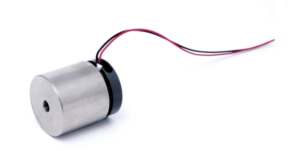The latest entry in the Magnet-Schultz of America Solenoid 101 blog explains the basic concept and function of voice coils. This blog builds on our general overview of solenoid principles and applications, which can be found HERE. Check our blog history for information on more technical concepts and feel free to make suggestions for future posts.
What is a Voice Coil?
Like a solenoid, a voice coil is an electromechanical device used to convert electrical energy into linear motion. Despite the similar objective, the devices differ significantly in design and application. A voice coil has a tubular wound coil that is continuously acted upon by permanent magnets installed in the armature. As current is applied to the coil, the magnetic field generated by the coil interacts with the permanent magnetic field of the armature and creates axial motion. The unpowered voice coil sits at a neutral position and depending on the polarity of the current applied the axial motion can be created in either direction away from the neutral position. This means that unlike a solenoid, a single voice coil can operate in both directions without assistance from a spring or secondary coil.

Voice Coil Cross Section
Force and Stroke Characteristics
A solenoid will have a stroke force profile that is very high at the fully retracted position. As distance from the solenoid’s fully retracted position increases, the force applied decreases. This results in a force profile that has a consistent downward trend. The profile for a voice coil will look very different because the voice coil stroke originates at a center point and travels outward in both directions. The highest forces provided are near the voice coil’s neutral position. When looking at a force profile for a voice coil, it will spike at the center, and deteriorate at either end of the full range of motion. That being said, voice coils can be designed with flatter force profiles throughout the required stroke than is usually present in solenoids.
Design Styles
The motion of the voice coil’s armature and coil is relative, so either component can be designed to function as the stationary mounting surface. This leads to two primary voice coil design categories, moving coil and moving armature. Moving armature designs reduce concerns about lead wire wear, since the coil remains stationary. Moving coil designs provide faster response times and higher acceleration because the mass of the coil is comparatively less than the mass of the armature. More complex design modifications can also be made to accomplish functions like rotary motion.

Compared to solenoids, voice coils provide higher actuation speeds, greater position accuracy, and bi-directional capabilities. This makes them ideal for use in precision applications in the medical, aerospace, optical, and audio industries.
Magnet-Schultz of America specializes in the custom engineering and manufacturing of solenoids, solenoid valves, electromagnets, voice coils, hydraulic tubes and coils, and locking devices. If you have any questions related to sourcing or manufacturing, please contact us. We will be happy to assist in the development of your application. Browse past blogs for a more in-depth look at solenoid functions and subscribe to the notifications for future posts!






Leave A Comment